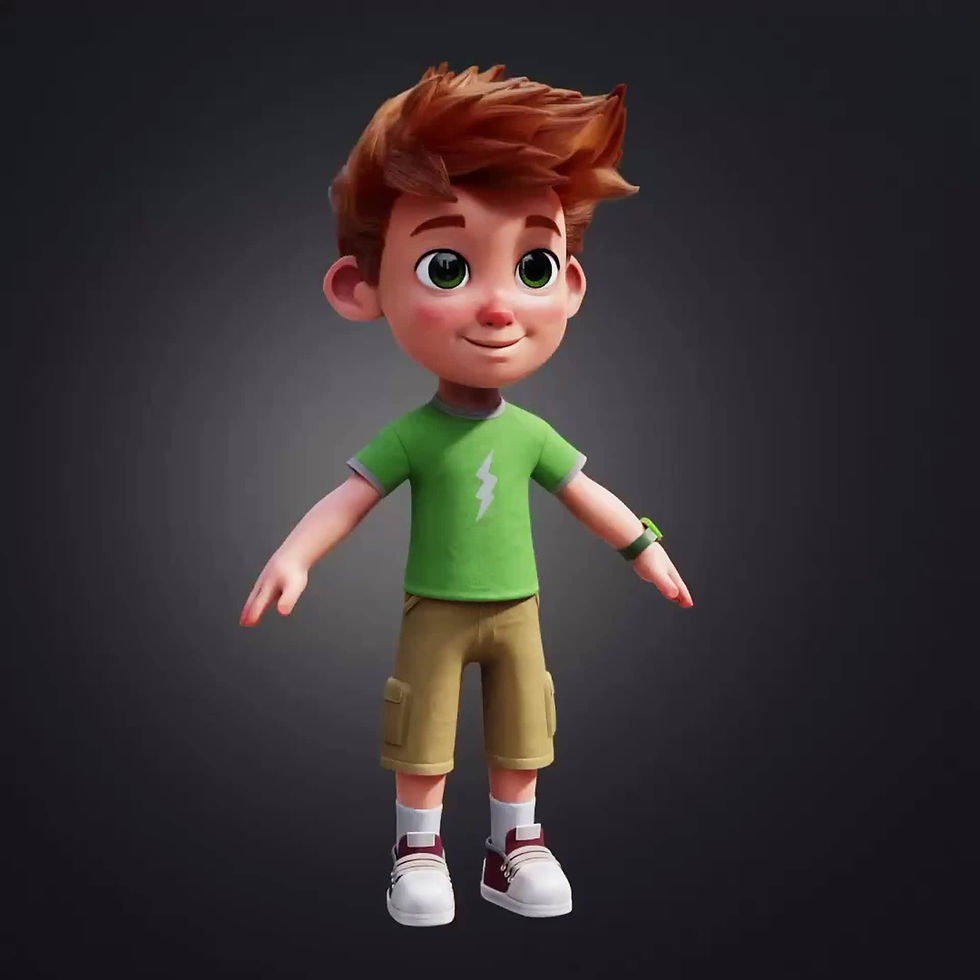What is the Difference Between 2D and 3D Animation?
- Webs Husky
- Jan 1
- 4 min read
Updated: Jan 3

The art of animation uses motion and narrative to give life to people, things, and environments. It is a strong medium that is applied in a variety of sectors, like gaming, advertising, education, and entertainment. Let's look at the distinctive qualities, benefits, and drawbacks of 2D and 3D animation as we compare and contrast them.
How does animation work?
Animation is the process of producing the illusion of motion and change by displaying a series of static images with slight differences from one another. Animators create animations using a variety of methods, typically employing software to produce visually appealing and interesting material. There are two main categories of animation:
Animation Categories
2D Animation: This type of animation involves creating two-dimensional, flat images with movement confined to a single plane. Examples include classic cartoons such as Tom and Jerry or The Flintstones.
3D Animation: 3D animation, on the other hand, provides a more realistic and immersive experience by creating three-dimensional models capable of moving in all directions. Examples include animated movies such as Toy Story and Frozen.
What Separates 2D Animation from 3D Animation
The goal of both 2D and 3D animation is to tell tales or deliver messages, but their methods, styles, and uses are very different. Here are five major variations:
Dimension and Appearance:
2D animation appears flat, operating within height and width dimensions.
3D animation adds depth, creating lifelike and realistic visuals.
Techniques Used:
2D animation involves hand-drawn illustrations or vector graphics.
3D animation relies on digital modeling, rigging, and rendering.
Cost and Time:
2D animation is generally more cost-effective and quicker to produce.
3D animation often requires advanced software and higher budgets due to its complexity.
Applications:
Creative Flexibility:
2D allows for stylized and exaggerated visuals.
3D emphasizes realism and intricate detailing.
What is 2D Animation?

2D animation is the technique of producing graphics in two dimensions. Animators use computer graphics or drawings that move either vertically or horizontally to represent motion. Disney's Snow White and the Seven Dwarfs and anime shows like Naruto are classic instances of 2D animation.
Advantages of 2D Animation
Affordable:
2D animation is an affordable choice for companies with tight budgets because it usually requires fewer resources to produce.
Faster Production:
Due to its simplicity, 2D animation takes less time to complete compared to 3D animation.
Artistic Flexibility:
Artists have the freedom to create highly stylized and unique designs that can’t always be replicated in 3D.
Suitable for Various Platforms:
2D animation works well for educational content, advertisements, and mobile applications.
Easy Updates:
Changes and revisions in 2D animation are often more straightforward.
Disadvantages of 2D Animation
Limited Realism:
2D lacks the depth and dimensionality needed for highly realistic visuals.
Restricted Camera Angles:
Since 2D operates on a flat plane, dynamic camera movements are harder to achieve.
Manual Effort:
Each frame must be manually drawn or adjusted, which can be labor-intensive.
Lesser Demand in Some Industries:
With the rise of 3D animation, some industries prefer the latter for its immersive capabilities.
What is 3D Animation?

3D animation is the process of producing models that exist in three dimensions. Animators create, rig, and animate objects or characters using specialized software. Pixar movies and computer games like The Last of Us are examples of 3D animation.
Advantages of 3D Animation
Realistic Visuals:
3D animation offers lifelike representations that are visually stunning and immersive.
Dynamic Camera Movements:
Creators can achieve complex camera angles and movements to enhance storytelling.
Broad Applications:
3D animation is widely used in movies, video games, simulations, and virtual reality.
Reusability:
Once a 3D model is created, it can be reused in various projects, saving time and effort.
Scalability:
3D animation can handle fine details, making it ideal for luxurious productions.
Disadvantages of 3D Animation
Higher Costs:
The production of 3D animation requires advanced tools, skilled professionals, and substantial budgets.
Time-Consuming:
Creating 3D animation involves multiple stages, including modeling, rigging, texturing, and rendering.
Steeper Learning Curve:
Mastering 3D animation tools and techniques can be challenging for beginners.
Risk of Over-Realism:
Sometimes, excessive realism can detract from the artistic or whimsical appeal of an animation.
Resource-Intensive:
Rendering 3D animations demands significant computing power, which can be a limiting factor.
How Can Someone Enter the Field of 2D or 3D Animation?
To start your animation career, consider the following steps:
Learn the Basics: Familiarize yourself with the principles of animation, such as timing, spacing, and movement.
Choose Your Path: Decide whether you want to focus on 2D or 3D animation based on your interests and goals.
Gain Skills: Enroll in courses or tutorials to learn animation software like Adobe Animate (for 2D) or Blender (for 3D).
Build a Portfolio: Create sample projects to showcase your skills to potential employers or clients.
Network: Join online forums, communities, or events to connect with other animators and industry professionals.
FAQs
Is 3D Animation Better Than 2D Animation?
Each has its strengths. 3D animation excels in realism and versatility, while 2D animation offers simplicity and artistic expression.
Which Is Better – 2D or 3D Animation?
The choice depends on the project’s goals, budget, and audience preferences. Both have unique applications.
Which Is Harder, 2D or 3D Animation?
3D animation is often considered more complex due to its technical requirements, but 2D animation can be equally challenging in terms of creativity and manual effort.
Are Cartoons 2D or 3D?
Cartoons can be either 2D or 3D. Traditional cartoons like Looney Tunes are 2D, while modern animated series may use 3D techniques.

Comments